An In-Depth Review of Yellow Corn and Soybeans; Soybean Flowering Gets An Early Start
BY Dairyland Seed Agronomy Team
WHY IS MY CORN PALE/YELLOW?
We addressed yellow corn earlier this season, but this is a problem that has been persisting across our regions for a while now. The yellow and striped corn we are observing could have several causes.
The first possibility and, perhaps everyone’s knee jerk reaction, is nitrogen deficiency. Deficiency doesn’t mean there isn’t enough nitrogen applied; it may just be out of “reach” of the young roots at this time. Most of the yellow and striped corn we have dealt with is on lighter textured soils. Thus, we could be experiencing some leaching just beyond where the roots are growing. However, except for our more southern geographies, most areas were dry. The other scenario is that we just don’t have our sidedress application on at this time and the plants are growing faster than nitrogen can be supplied.
The second possible reason for yellow corn is the weather has finally become favorable for rapid vegetative growth. The yet developing permanent root system can’t keep up supplying the nitrogen, sulfur and zinc needs of the quick growing plant. As a result, we see the tell-tale signs of yellow corn.
The next reason for yellow striped corn, especially on lighter soils, can be Sulphur deficiency. Sulphur is mobile in the soil much like nitrogen. Heavy rains in the spring can move this nutrient out of contact with the young root system. For most of the Dairyland Seed marketing area, this was not the case. There were a few general areas that did get heavy rains, and it seems to be more prevalent there. The cool conditions restricting root growth in late April and early May kept the plants from accessing what sulfur was available.
As the season has progressed, yet another possible cause has been Zinc deficiency. Zinc deficiency will have the yellow stripes in addition to a whiteish color toward the base and mid rib of the leaf. All three nutrient deficiencies will look similar with interveinal chlorosis and striping at some point in time. Factors that may encourage zinc deficiency include high pH, very high phosphorus levels, sandy light textured and high organic matter soil. Weather conditions favoring Zinc deficiency are typically cool and wet with limited sun. We certainly had cool in most all cases, but perhaps not as much wet.
In most all situations, more ideal growing conditions should alleviate the symptoms. In others, completion of sidedress operations, in combination with growing conditions, will snap plants into shape. In many areas the addition of sulfur or zinc may be warranted. If this the case, a pretty standard practice is about 20 pounds of sulfur and 15 to 30 pounds of zinc sulphate. Another consideration may be the addition of micro nutrient as a foliar feed; especially if it can be added to your post emergent herbicide application.
If you have further questions or concerns feel free to contact your local Dairyland Seed Agronomist.
WHAT IS THE CAUSE OF MY PALE/YELLOW SOYBEANS?
In the last week, we have seen an influx of inquiries about yellow or pale colored corn and soybeans. There are many factors that can have this impact on corn and soybeans. The most common cause for the color changes are nutrient deficiencies within the plant which are brought on by environmental conditions or herbicide applications. When a plant exhibits symptoms of a given nutrient deficiency, there may be adequate amounts of that nutrient in the soil or even in the plant itself, but saturated or dry soil conditions can make the nutrient unavailable to the plant and herbicide applications can tie up nutrients within the plant to the point of yellowing.
Many stressors and environmental conditions can impact the color of soybean plants during early rapid growth and post herbicide application time. The most common causes for yellowing in soybeans during this time are Manganese deficiency, Iron deficiency (IDC iron deficiency chlorosis) and yellowing brought on by herbicide application.
Manganese
Manganese deficiency will be noticeable in a soybean field due to a yellow cast in a given area. When examining an individual plant, interveinal chlorosis or yellowing between the veins, and necrotic or small brown spots will be visible between the veins of the soybean leaf. High pH, dry soil conditions, and course soil types are all soil conditions that can cause Mn symptoms. Certain areas of fields will show Mn deficiency year after year unless otherwise addressed. The application of Manganese Sulfate to raise Mn soil levels can be difficult due to the Mn being rapidly tied up in the soil. The quickest and most often most economical remedy for Mn deficiency is the application of Mn foliar products at a rate of 1 pound of Mn per application. Yellowing of soybeans leaves caused by glyphosate application is often result Mn in the plant tissue being tied up and made unavailable to the plant by the glyphosate. The addition of EDTA chelated Mn can help to alleviate the “yellow flash” of glyphosate applications.
Iron
Iron Deficiency Chlorosis is most readily identified by interveinal chlorosis or yellowing between the veins of the soybean leaf. The veins of the leaf will remain dark green and the tissue between will yellow. IDC will often appear in areas of high pH and saturated soil conditions. There is often adequate amounts Iron in the soil for soybean production, but these adverse soil conditions do not allow the plant to access the Iron (that is, the Iron is not available in solution). Similar to Mn deficiency, IDC symptoms can be brought on by in season herbicide applications. As the plants metabolize the herbicides, Iron can be tied up by the chemical or stress the plant to the point of displaying similar symptoms. Applications of foliar Iron fertilizer applications have shown to only be cosmetic. Most generally, the symptoms will alleviate as the soil conditions improve or the soybean plant metabolizes the herbicide. Planting soybean varieties with a good IDC rating in known problem fields has proven as a great tool to manage IDC.
SOYBEAN FLOWERING AND SWM
As we move into the middle of June and pass the longest day and subsequently the shortest night of the year, (Summer Solstice or first day of summer), I start looking for flowers on soybean plants. This year I spotted flowers on June 16th, which is tied with 2012 with the earliest that I have seen flowers on soybean plants. This brings up the point that soybean plants can start the flowering process from V2 to V8 (2nd to 8th Trifoliolate) and, with early planting dates, can start flowering prior to Summer Solstice. Drought stress can induce plants into flowering. Conversely, soybeans that are planted early and have good fertility are also more prone to flowering early. The photograph below shows soybean growth stages VE to V3.
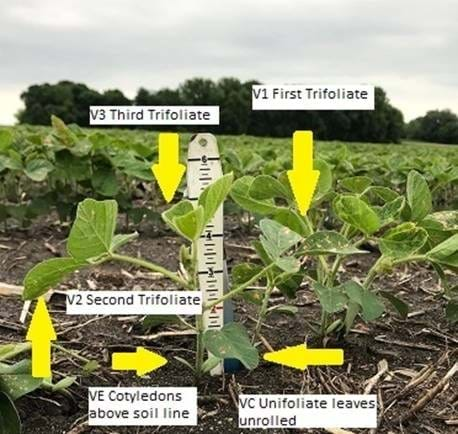
Once a soybean plant starts to flower, it is in the Reproductive phase or R1 which is Beginning Bloom when one open flower on any node on the main stem shown below and on the left.
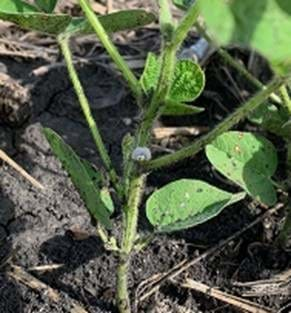
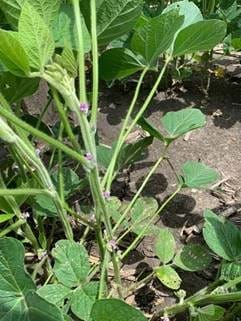
The photo above on the right shows a soybean plant in the R2 growth stage which is Full Bloom when an open flower is on one of the two uppermost nodes on the main stem. Peak flowering occurs at Beginning Pod development (R3), with flowering continuing until Beginning Seed (R5) or shortly thereafter. Soybean plants will flower and put on vegetative growth at the same time. Not every flower or blossom will produce a pod. In fact, it is not unusual for soybeans to abort 60 to 70 percent of its flowers. The issue with aborted flowers, besides reduced yield potential, is that it provides an opening for a fungus Sclerotinia sclerotiorum (which causes White Mold) to enter the plant.
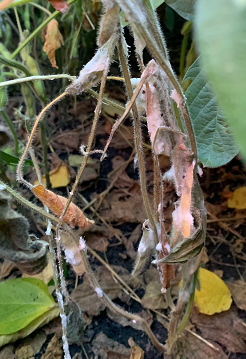
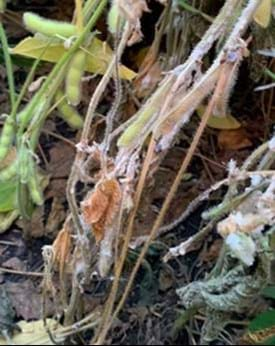
If you are looking at applying control measures to a field planted in soybeans this year and the field has a history of White Mold (SWM), many Fungicides such as Approach, recommend applications at R1 followed by another application at R3. This tends to make sense in that most fungicides do not move into new growth, and an additional application at R3 would provide supplementary coverage to new flowers and vegetative growth on the plant.
Many herbicide labels place restrictions on application timing for crop safety as well as environmental and rotation concerns.
If you have any questions regarding this or other Agronomic topics contact your Dairyland Seed Regional Agronomist.
 |
 |
 |
 |
 |
| Brian Weller Western Region 507.456.3034 |
Dan Ritter Central Region 219.863.0583 |
Branden Furseth Northern Region 608.513.4265 |
Mark Gibson Eastern Region 260.330.8968 |
Amanda Goffnett Eastern Region 989.400.3793 |
